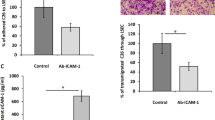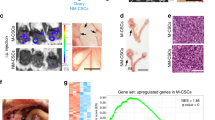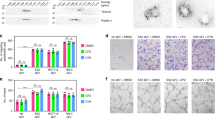Abstract
Metastatic variant sublines of the murine large-cell lymphoma cell line RAW117 were tested for their growth and migration properties in vitro in medium conditioned by soluble factors released from syngeneic mouse liver-, lung-, and brain-derived microvessel endothelial cells. Medium conditioned with hepatic sinusoidal endothelial cells stimulated the growth of highly liver-colonising (RAW117-H10) and highly liver- and lung-colonising (RAW117-L17) sublines at higher rates than the poorly metastatic parental line (RAW117-P) (H10 greater than L17 greater than P). Medium conditioned with lung microvessel endothelial cells selectively stimulated the growth of the lung-colonising RAW117-L17 subline. Medium conditioned with brain microvessel endothelial cells showed no growth selectivity, and equivalently stimulated the growth of various RAW117 cell sublines. Medium conditioned with hepatic sinusoidal endothelial cells preferentially promoted the migration of the liver-colonising H10 and L17 sublines, and medium conditioned with lung endothelial cells differentially stimulated the migration of the lung-colonising L17 subline; whereas medium conditioned with brain endothelial cells only slightly stimulated the migration of L17, but not H10 or P cells. Fractionation of medium conditioned with hepatic sinusoidal endothelial cells by DEAE Sephacel anion exchange chromatography revealed that the growth-stimulating activities were clearly separable from migration-stimulating activities. The growth- and migration-stimulating activities released from organ microvessel endothelial cells may be important in determining the ability of RAW117 cells to selectively form metastatic colonies in particular organs.
This is a preview of subscription content, access via your institution
Access options
Subscribe to this journal
Receive 24 print issues and online access
$259.00 per year
only $10.79 per issue
Buy this article
- Purchase on Springer Link
- Instant access to full article PDF
Prices may be subject to local taxes which are calculated during checkout
Similar content being viewed by others
Author information
Authors and Affiliations
Rights and permissions
About this article
Cite this article
Hamada, J., Cavanaugh, P., Lotan, O. et al. Separable growth and migration factors for large-cell lymphoma cells secreted by microvascular endothelial cells derived from target organs for metastasis. Br J Cancer 66, 349–354 (1992). https://doi.org/10.1038/bjc.1992.269
Issue Date:
DOI: https://doi.org/10.1038/bjc.1992.269
This article is cited by
-
Image-Assisted Microvessel-on-a-Chip Platform for Studying Cancer Cell Transendothelial Migration Dynamics
Scientific Reports (2018)
-
Tumour endothelial cells in high metastatic tumours promote metastasis via epigenetic dysregulation of biglycan
Scientific Reports (2016)
-
Potentiation of angiogenic switch in capillary endothelial cells by cAMP: A cross-talk between up-regulated LLO biosynthesis and the HSP-70 expression
Glycoconjugate Journal (2006)
-
The transition to the metastatic phenotype of rat lymphoma cells involves up-regulation of IL-10 receptor expression and IL-10 secretion
Clinical & Experimental Metastasis (2005)
-
Association between systemic sclerosis and breast cancer: eight new cases and review of the literature
Clinical Rheumatology (2004)



